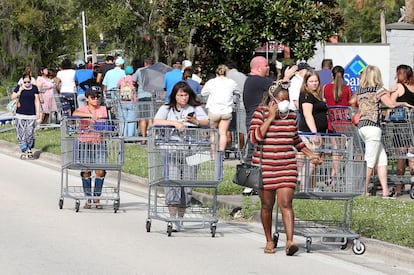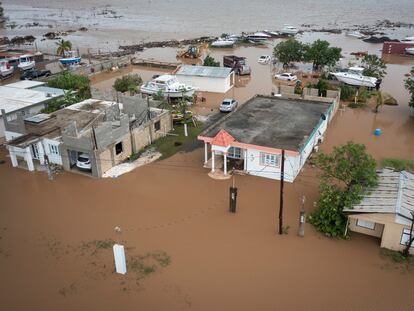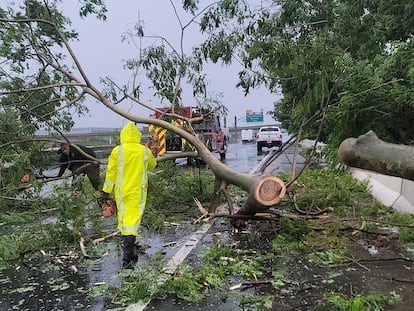Ian becomes a hurricane on its way to Florida and Cuba
The storm is expected to make landfall on the Caribbean island on Tuesday and on the west coast of the US state by Thursday. Authorities are warning residents to prepare for ‘state of emergency’ conditions

Ian is officially a hurricane. The US National Hurricane Center (NHC) has issued an advisory warning that it is expecting “conditions in western Cuba to deteriorate this evening and tonight with significant wind and storm surge impacts expected.”
The path predicted by the NHC indicates that Ian will make landfall on the western coast of Cuba at 2am this Tuesday, then continue on a course towards northwestern Florida, where it will hit hard mainly between Thursday and Friday. The tropical storm is expected to dump heavy rain on Florida, Georgia, Alabama and South Carolina on Friday and Saturday, although the trajectory is always more uncertain after three or four days.
Analysis of satellite and aircraft images show that Ian has become the fourth hurricane of the season. Currently, the eye of the hurricane is in the vicinity of the island of Grand Cayman, and it is expected to continue moving north in the coming hours. The storm is moving at a speed of about 14 miles per hour (22.5 kilometers per hour), with sustained winds reaching 75 miles per hour (120 kilometers per hour), just above the 74-mile-per-hour limit that is conventionally used to classify a storm of this type as a hurricane.
US President Joe Biden declared an emergency on Saturday affecting numerous counties in Florida. This move authorizes the Department of Homeland Security and the Federal Emergency Management Agency (FEMA) to coordinate all disaster relief efforts and provide appropriate assistance. Numerous Florida colleges and universities have suspended classes in anticipation of the tropical storm. Biden has postponed a trip to Florida that he had planned for Tuesday because of the storm.

Florida Governor Ron De Santis has also declared an emergency situation throughout the state. “There is a continuing risk of dangerous storm surge, heavy rain, flash flooding, high winds, dangerous seas and isolated tornado activity,” he said in a statement. “Due to the above conditions, which are anticipated to constitute a major disaster, I hereby declare that a state of emergency exists in the State of Florida.”
“We are coordinating with all state and local government partners to track the potential impacts of this storm,” De Santis said in a statement. The Florida Division of Emergency Management (FDEM) is mobilizing food and water trucks, generators and water pumps, identifying potential logistics storage areas to ensure food and water are available if requested. The governor has also mobilized 2,500 Florida National Guardsmen, according to an update released Sunday.
Authorities have asked the population to prepare by stocking up with supplies and water for at least a week. Last weekend, long lines could be seen in some supermarkets and megastores as residents prepared for the arrival of the tropical storm.
Tu suscripción se está usando en otro dispositivo
¿Quieres añadir otro usuario a tu suscripción?
Si continúas leyendo en este dispositivo, no se podrá leer en el otro.
FlechaTu suscripción se está usando en otro dispositivo y solo puedes acceder a EL PAÍS desde un dispositivo a la vez.
Si quieres compartir tu cuenta, cambia tu suscripción a la modalidad Premium, así podrás añadir otro usuario. Cada uno accederá con su propia cuenta de email, lo que os permitirá personalizar vuestra experiencia en EL PAÍS.
¿Tienes una suscripción de empresa? Accede aquí para contratar más cuentas.
En el caso de no saber quién está usando tu cuenta, te recomendamos cambiar tu contraseña aquí.
Si decides continuar compartiendo tu cuenta, este mensaje se mostrará en tu dispositivo y en el de la otra persona que está usando tu cuenta de forma indefinida, afectando a tu experiencia de lectura. Puedes consultar aquí los términos y condiciones de la suscripción digital.
More information

From Maria to Fiona: The hurricane nightmare returns to Puerto Rico
Últimas noticias
Maduro pleads not guilty before the federal court in New York: ‘I am still the president of Venezuela’
A new test can detect Alzheimer’s from a finger prick
UN team enters Sudanese city of El Fasher after paramilitary massacre: ‘It’s like a ghost town’
A recipe for resistance: Indigenous peoples politicize their struggles from the kitchen
Most viewed
- Gilles Lipovetsky: ‘If you want to live better and fall in love, take Prozac, don’t look to philosophy’
- Alain Aspect, Nobel laureate in physics: ‘Einstein was so smart that he would have had to recognize quantum entanglement’
- Alvin Hellerstein, a 92-year-old judge appointed by Bill Clinton, to preside over Maduro’s trial in New York
- Why oil has been at the center of Venezuela-US conflicts for decades
- Maduro’s downfall puts China’s relationship with Venezuela to the test









































